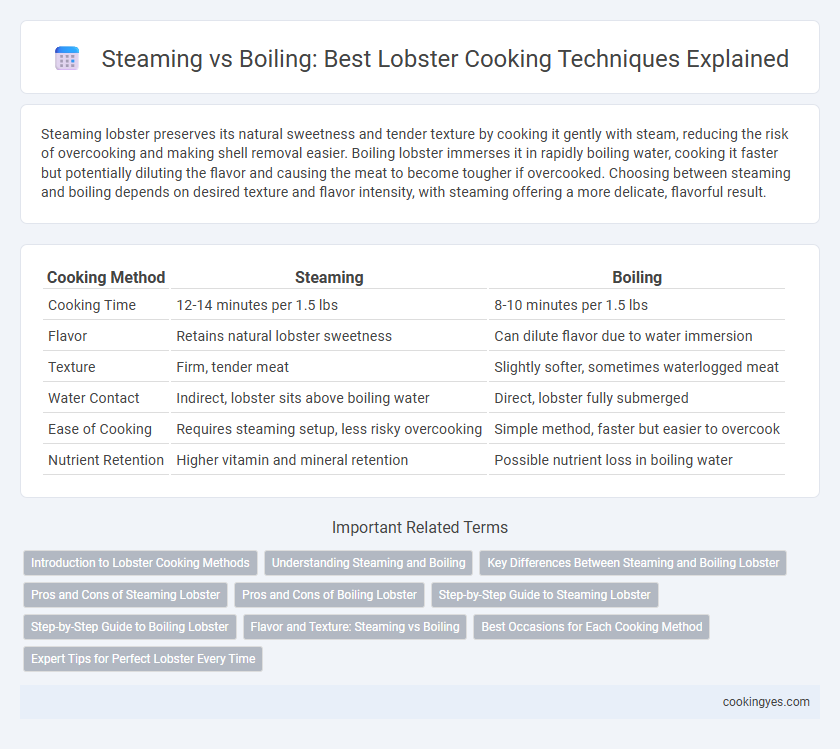Steaming lobster preserves its natural sweetness and tender texture by cooking it gently with steam, reducing the risk of overcooking and making shell removal easier. Boiling lobster immerses it in rapidly boiling water, cooking it faster but potentially diluting the flavor and causing the meat to become tougher if overcooked. Choosing between steaming and boiling depends on desired texture and flavor intensity, with steaming offering a more delicate, flavorful result.
Table of Comparison
| Cooking Method | Steaming | Boiling |
|---|---|---|
| Cooking Time | 12-14 minutes per 1.5 lbs | 8-10 minutes per 1.5 lbs |
| Flavor | Retains natural lobster sweetness | Can dilute flavor due to water immersion |
| Texture | Firm, tender meat | Slightly softer, sometimes waterlogged meat |
| Water Contact | Indirect, lobster sits above boiling water | Direct, lobster fully submerged |
| Ease of Cooking | Requires steaming setup, less risky overcooking | Simple method, faster but easier to overcook |
| Nutrient Retention | Higher vitamin and mineral retention | Possible nutrient loss in boiling water |
Introduction to Lobster Cooking Methods
Steaming lobster preserves more of its natural flavor and texture by cooking the shellfish gently with steam, typically maintaining a tender and moist interior. Boiling lobster involves submerging the lobster in rapidly boiling water, which cooks the meat faster but can sometimes lead to a firmer texture and slight loss of flavor. Each method impacts cooking time and flavor retention, influencing the final delicacy experience.
Understanding Steaming and Boiling
Steaming lobster preserves more natural flavor and texture by gently cooking the meat with indirect heat from the boiling water's steam. Boiling submerges the lobster fully, resulting in faster cooking but can dilute taste and make the meat slightly tougher due to direct contact with boiling water. Understanding the differences in heat transfer and moisture retention is crucial for achieving the desired lobster texture and flavor profile.
Key Differences Between Steaming and Boiling Lobster
Steaming lobster preserves more natural flavors and results in a tender, less waterlogged texture by cooking the lobster above boiling water, while boiling submerges the lobster in rapidly boiling salted water, which can lead to a slightly firmer texture and faster cooking time. Steaming typically takes longer, about 10-20 minutes depending on size, and reduces the risk of losing nutrients and flavor into the cooking water. Boiling, preferred for larger quantities, maximizes heat transfer and often produces more evenly cooked lobster but can dilute its delicate sweetness.
Pros and Cons of Steaming Lobster
Steaming lobster preserves more of its natural flavor and texture by cooking it gently, reducing the risk of overcooking and making the meat tender and succulent. This method allows for better control of cooking time and helps maintain the lobster's moisture, resulting in a juicier final product. However, steaming takes longer than boiling and may require more careful attention to ensure even cooking throughout the lobster.
Pros and Cons of Boiling Lobster
Boiling lobster ensures even cooking and faster preparation time while effectively infusing the meat with salt from the seawater or added salt in the pot, enhancing flavor. However, boiling can cause the lobster shell to become tougher and sometimes leads to overcooked, rubbery meat if not timed carefully. This method also risks dilution of the lobster's natural sweetness compared to steaming, which preserves more delicate flavors.
Step-by-Step Guide to Steaming Lobster
Steaming lobster preserves its natural flavors and ensures even cooking by gently surrounding the crustacean with hot steam instead of submerging it in water. Start by adding 2 inches of water to a large pot, insert a steaming rack, bring the water to a rapid boil, and then place the lobster on the rack with the lid securely in place. Steam the lobster for 10-12 minutes per pound until its shell turns bright red and the meat becomes opaque and firm, signaling optimal doneness.
Step-by-Step Guide to Boiling Lobster
Boiling lobster involves submerging it in a large pot of vigorously boiling salted water, which ensures even cooking and a tender texture. Start by bringing at least 3 quarts of water per lobster to a rolling boil, add 2 tablespoons of salt per quart, then carefully place the lobster headfirst into the pot to minimize distress. Boil lobster for approximately 7-10 minutes per pound, turning once halfway, until the shell turns bright red and the meat is opaque and firm for optimal flavor and safety.
Flavor and Texture: Steaming vs Boiling
Steaming lobster preserves its sweet, delicate flavor and results in tender, succulent meat by cooking it gently with moist heat. Boiling, while faster, can cause some flavor loss and a firmer texture due to the direct exposure to rapidly boiling water. Choosing steaming enhances the lobster's natural taste and maintains a more desirable, juicy texture.
Best Occasions for Each Cooking Method
Steaming lobster preserves its natural sweetness, making it ideal for smaller lobsters and delicate dining experiences where flavor retention is prioritized. Boiling suits larger lobsters and casual gatherings, as it cooks quickly and evenly, making it perfect for bulk preparation. Both methods offer a reliable way to ensure tender meat, with steaming favored for flavor and boiling chosen for efficiency.
Expert Tips for Perfect Lobster Every Time
Steaming lobster preserves its natural sweetness and tender texture by cooking the meat gently with moist heat, requiring about 10-12 minutes for a 1.5-pound lobster. Boiling, which immerses the lobster fully in salted water at a rolling boil, can cook it faster but risks diluting flavor and toughening the meat if overcooked. Experts recommend using a large pot with properly salted water for boiling and a pot with a tight-fitting lid and a steaming rack for steaming to ensure even heat distribution and consistently perfect lobster every time.
Steaming vs Boiling for lobster cooking techniques Infographic

 cookingyes.com
cookingyes.com